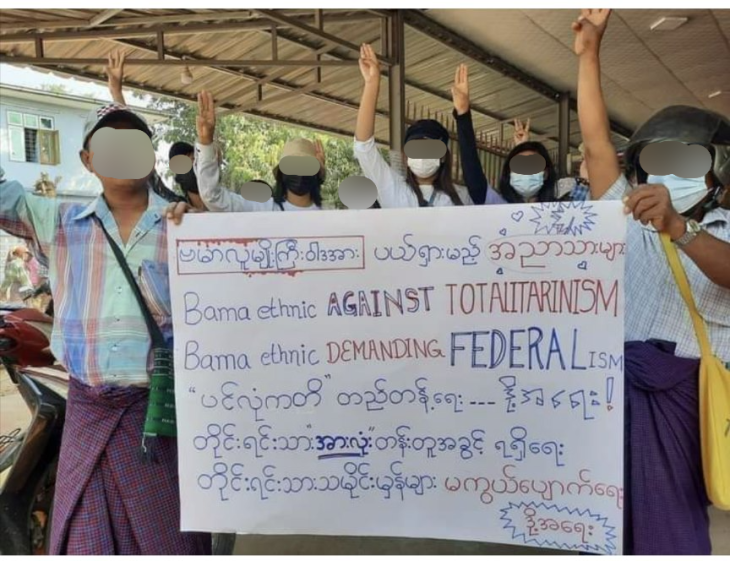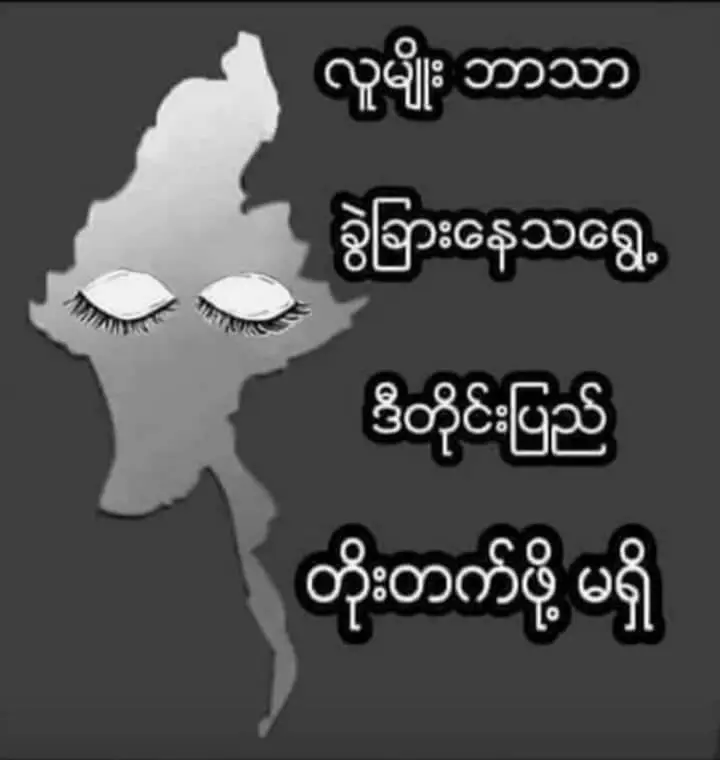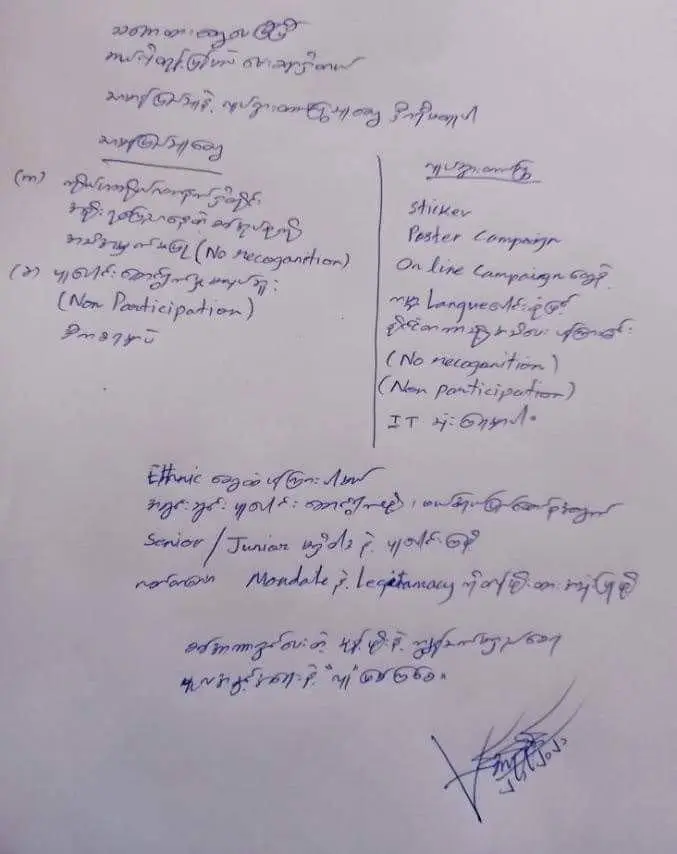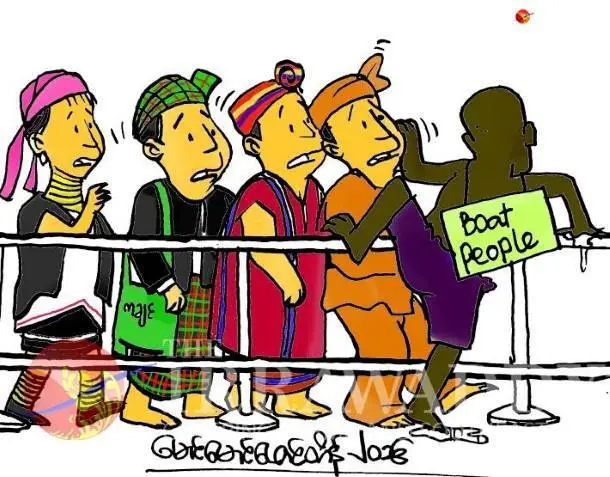Stephen Campbell and Elliott Prasse-Freeman argue that to redress entrenched Burman chauvinism, radical political economic restructuring is necessary.
Author’s note: The following is a summary and post-coup adaptation of a longer article in Journal of Contemporary Asia entitled “Revisiting the wages of Burman-ness: Contradictions of privilege in Myanmar,” which was accepted for publication in October 2020, and which elaborates these points in detail.
The February 2021 military coup that has shaken Myanmar and ended the country’s fraught experiment with liberal transition has left millions of Burmese furious and disgusted. But despite hundreds of protesters slaughtered by the military and thousands more infected by a COVID-19 wave exacerbated by military negligence, those feelings have not metastasized into generalized despair. This seems, in part, because activists and the public writ large have sublimated their opprobrium and anger into political projects: specifically, rather than only condemning the coup and demanding a return to the earlier status quo, popular movements have interpreted the seizure of power by the sit-tat[1] as implicit commentary on the contradictory conditions of the earlier democratic moment. Some protestors thus sought to push beyond an earlier imaginative failure. This became clear symbolically when, early in the uprising, protesters began spontaneously eschewing the red of the National League for Democracy (NLD), donning black instead, therein indicating the necessity of a new politics.
And while many have retained faith in an NLD-centered politics, other protesters – in particular activists such as Ei Thinzar Maung (now NUG Deputy Minister for Women and Youth) and Thinzar Shunlei Yi – have made it explicit that a new politics is necessary. This politics, they say, must address inter-ethnic injustice that had for years been brushed aside by the very same democratic leaders, particularly Aung San Suu Kyi, who had been deposed. She had, after all, patronizingly told ethnic minorities to sacrifice their interests for the nation, aligned with the military in its negotiations with ethnic armies, and provided the sit-tat cover by defending it against charges of genocide while denying its campaign of mass rape. By contrast, an outpouring of popular discourse, much rendered in street protest signs, implicitly repudiated those positions, addressing the collective failure for the polity’s majority – the Burmans – to care for inter-ethnic issues. Many identified how the military had revealed that it ultimately viewed all of its subjects as subject to brutal domination; as one popular sign put it:
“First they came for the Karen, and we didn’t speak out. Then they came for the Rohingya, and we didn’t speak out. Now they are coming for ALL OF US.”
Others addressed themselves to ethnic groups, Rohingya included, apologizing either for not believing reports about abuse and genocide, or not taking action. Many endorsed trans-ethnic solidarity (Figure 1); others directed anti-coup energies not just at the State Administrative Council (SAC) that had seized power, but at a more general “Burman chauvinism” (Figure 2).


But even as conversations on Burmese Facebook focused on how Burmans must acknowledge and apologize for past abuses, there has been a perceptible gap between self-flagellation and material steps that would precipitate substantive change. Nowhere has this been registered more starkly than in comments by ethnic nationality subjects who have expressed skepticism that these declarations of solidarity would translate beyond the struggle against the SAC. To take one example, after Min Ko Naing, in an early outline of what would become CDM, which he sketched on 2 Feb and which his comrades passed to one of us, exhorted everyone to “beg the ethnics” (see Figure 3), an online commentator questioned the sincerity of his commitment to equality, adding: “When things are ok for you again, you will forget about us.”[2]

This leaves a burning question: if this is indeed an inflection point in how ethnic justice is considered by many in Myanmar, and if Burmans are in fact interrogating the privileges they have enjoyed, how can these be translated into substantive political programs that will transform a future society? Specifically, how effective can we expect such performances of apology and acknowledgment to be in bringing along those Burmans who support right-wing Burman Buddhist movements? Will they feel they have much to apologize for? Moreover, if we consider those who do not endorse such ideologies but who have nonetheless been excluded from the largesse of Myanmar’s “development” over the past decade, are they likely to suddenly identify ethnic others as brothers and sisters rather than threats to their livelihoods and social reproduction who are “jumping the queue” (Figure 4).

As these hypotheticals suggest, apologies and the acknowledgment of unearned benefits – what we call “liberal privilege theory” – may founder against entrenched realities in Myanmar and remain feel-good performances of virtue signaling that, while able to absolve guilt, leave inequality firmly intact. In what follows, we draw on our recent article, “Revisiting the wages of Burman-ness: Contractions of privilege in Myanmar,” published in Journal of Contemporary Asia, to describe facets of this theory and how it plays out in Myanmar studies scholarship, before turning to a radical strain of privilege theory to advance an argument for why this more radical articulation of privilege has the potential to fundamentally redress entrenched Burman chauvinism.
The analytic of “Burman privilege” has been popularized in Myanmar studies circles through the influential article “The Wages of Burman-ness” by Matthew Walton. Walton begins by outlining a theory of white privilege, as it has been used in the United States, to conceptualize unearned material benefits – “wages” – that white people enjoy by dint of the US’s structurally-entrenched and long-unacknowledged white supremacy. He then identifies the parallels between American whites and Burmans, while adding that it is particularly challenging for Burmans to perceive these benefits because they too have been oppressed by Myanmar’s military governments and because many are not aware of the disproportionate suffering endured by ethnic members of the polity. One of Walton’s particular insights, for instance, is how he identifies the subtle false equivalence that Suu Kyi draws between Burman and ethnic nationality suffering under the sit-tat:
Not only does [Suu Kyi] effectively ignore the historically real and continuing effects of ethnic conflict, she does not acknowledge the disparities in sacrifice and suffering experienced by non-Burman ethnic groups. She asks them to put aside their own experiences of injustice and oppression to follow her plan (Walton 2013:16).
There is much to recommend in Walton’s article, particularly given that it was published nearly a decade ago. And his focus on Burmans is refreshing especially given the amount of blame put on ethnic groups for desiring autonomy and dignity. As Walton puts it, “Burman dominance and privilege can be overcome only through active struggle and repudiation by Burmans” (21) who are “the only group in a position to challenge structures of Burman privilege” (22).
But ultimately, because Walton takes Burman privilege as an un-analyzed outcome, such privilege appears as the aggregate product of individual bias – bias that can be excised from the body politic by the righteous actions of individual Burmans. And while we can think of important actions that such individuals can take that might change the minds of some – standing up against hate speech, challenging propaganda, encouraging people to know more about the history and perspectives of ethnic people – a question is whether such actions are enough. There is a risk they amount to allowing people to apologize for their privilege while doing little to change it. Moreover, even if self-examination was widespread and led to changed attitudes, the reality remains that given the skewed distribution of resources from earlier historical eras, whether there would be any real mechanism for redressing economic inequalities. This is ultimately why such an approach to racial/ethnic inequality remains liberal. For “liberal antiracist analysis,” writes Harsha Walia (2021: 13), “obsessed with superficial representation and flag-waving, purposefully fails to interrogate the material structures upending racism.”
Walton’s thesis thus ultimately offers a false promise that Burman privilege can be resolved without addressing those economic inequalities. Walton’s theory falls short not simply because economic justice is entwined in racial justice, but because capitalist class relations play a large role in generating those racial cleavages. This is the main thesis of the alternative and unfortunately somewhat displaced version of radical privilege theory articulated by W.E.B. DuBois more than a century ago, and since expanded upon by the Black radical feminist tradition, including the Combahee River Collective, Audre Lorde, bell hooks, and Keeanga-Yamahtta Taylor. And it is from this radical perspective that critics of racial privilege have identified whiteness as what scholars Noel Ignatin and Ted Allen call a “bourgeois poison” offered to all whites, but ultimately “utilized as a weapon by the ruling class to subjugate” not just non-whites, but poor whites as well.[3] More specifically, a material/ideological “wage” is offered to those interpellated into the dominant race/ethnicity – enticing even poor and otherwise exploited members to identify with and defend racialized class rule to the point of betraying their own interests – leaving them to defend a capitalist system that leaves them worse off. In other words, while a poor Burman might receive additional scraps from the proverbial table – in terms of having his culture exalted, in terms of her gaining a mild advantage in labor markets – these benefits pale in comparison to the benefits poor Burmans might gain by joining with non-Bama ethnics to reject the entire exploitative system.
Having clarified the radical theorization of racial/ethnic privilege, we can turn to Myanmar to assess the theory’s analytical usefulness in this otherwise different context.
In his article, Walton describes a long history of ethnic Burman chauvinism, one present during the anti-colonial struggle, which was waged, he has it, along specifically Burman ethnic lines. Walton argues that 1930s-era nationalist group Dobama Asiayone (“We Burmese Association”)—which he uses as a synecdoche for the entire nationalist movement—sought “to promote what [it] saw as ‘Burmese’ culture (in reality, Burman culture)” (Walton 2013: 8). But he bases this claim on a misreading of the 2000 article “The Concepts of Dobama (Our Burma) and Thudo-Bama (Their Burma) in Burmese Nationalism, 1930-1948” by Japanese scholar Kei Nemoto. In his misreading, Walton asserts that the Dobama fostered a racialized Burman against an internal enemy—the thudo-Bama (“Those Burmese”), which Dobama members “saw as collaborators with the British colonialists” (ibid). However, Nemoto stresses the mutability, rather than the fixity, of the concept of Burman, which was constructed in terms of vague nationalism and socialism. Moreover, Nemoto makes clear that the key distinction dividing dobama and thudobama was that between those who worked for the nation and those who did not. Here the thudobama were “the Burmese people who collaborated with the colonial regime” (Nemoto 2000: 1) – particularly Indians, Chinese, and kabya (those of mixed heritage who wanted to be white). And while traditional Burmese proverbs and literature presented upland tribes as “uncivilized,” such figures were incompatible with those performing the machinations resented by the thudobama. Moreover, as scholar Phyo Win Latt has identified in recent historical research, not only did the Dobama Asiayone include Rakhine, Shan, Indian, and so forth, but the figure of the “dobama Muslim” existed as a way to describe a patriotic Burmese Muslim. He argues that “Dobama” should be seen as an adjective describing a kind of conduct, a way of behaving, rather than a noun indexing an ethnic essence.
We would like to advance a humble provocation here: that “Burman” is more open than scholars have asserted—less rigidly reified in the ascriptive sense— but that its openness derives from its formation as a class-inflected hegemonic category. In this sense, “Burman-ness” operates even more effectively than does whiteness as a racialised category of class privilege, as it makes itself more available for entry of “non-Burmans” initially outside of it.
In particular, we argue that it was only in the post-Independence era that Burman-ness as a privileged social category became constructed against that of other ethnic nationalities—a process that was tied up in the particular dynamics of post-colonial capitalism. Indeed, not only were residents of Indian and Chinese ancestry dispossessed, and much of that property transferred to lowlanders (read: Burmans), but Nu’s independence government pursued a project of capitalist modernization in which Burmanization was inseparable from industrialization. Ne Win subsequently worked to establish state capitalism under military rule and further marginalize Indians and Muslims. With those groups marginalized, “development” in Burma was mostly enacted in the lowlands, and what little was brought to non-Burman spaces was still encoded as Burman: roads and bridges were icons of military state expansion rather than belonging to the nation.
“Burman” came to be linked with ideas of national progress, modernity, and development within Myanmar, while the non-Burman minorities went from being the backwards-but-assimilable cousins, to those who were impeding the march “toward a more modern and developed nation.” Propaganda and conventional wisdom in the lowlands had it that upland ethnic minorities undermined development either directly (by trying to leave the country and take resources with them), or indirectly (by causing trouble, which justifies military-state authoritarianism, which perpetuates civil war, which prevents development).
The result, for the social category “Bama,” was a clearer distinction from ethnic nationalities, even as the category remained incorporative. We argue that Burman-ness should best be understood as an identity that has a broad semiotic range, partaking of classic (if vaguely defined) “ethnic” indices, and privileged class-inflected expressions simultaneously. Put more clearly, in certain contexts (such as in rural villages) Burman-ness can be expressed through: modes of speaking (Burmese); worshipping (Buddhism); working (agrarian-based livelihoods); tracing genealogy (kinship); adorning the body (clothing, face cream, tattoos); and naming (having a “Burmese” name). Against this “strong” version of Burman-ness, however, significant deviation is permitted in relatively cosmopolitan contexts (urban areas). Numerous colleagues and informants, who are at least nominally non-Burman, have conveyed to us that they act as Burmans in their daily lives. As one puts it:
For people like me who live in cities and don’t speak an ethnic minority language, don’t have ethnic minority names and who are Buddhists, I don’t think it would be a problem to identify ourselves as “Bamar” in the first place…. I am Bamar… but also Mon, Pa-O, and Chinese.
Further, this particular informant stresses that asking what he really “is”—either Burman or non- Burman—misconstrues his lived mutability: that it is both/and rather than either/or.
As the now-moribund “transition” of the 2010s increased inequality – not only making more wealth available but fueling dispossession and destroying livelihoods for many poor people – ethnicity became more potent as a means of securing one’s life. This is at least one explanation for the rise of MaBaTha as a trans-ethnic movement (provided those ethnicities were over-coded as being predominantly Buddhist) that provided populist succor to the alienated and marginalized “Burman.”
In his 1963 novel, Yoma Taikbwe, ethnic Chin author Bhamo Tin Aung highlighted the challenges for inter-ethnic solidarity building against an historical backdrop of political economic inequality, particularly between the Burman lowlands and ethnic minority uplands.[4] But while not to be taken for granted, such solidarity, Bhamo Tin Aung suggests, is both possible and necessary for any collective emancipatory project. In a similar vein, we encourage here a more explicit discussion of political economic inequality as the material conditions of possibility for enduring ethnic division in Myanmar. From this perspective, durable inter-ethnic solidarity in the struggle against military rule requires explicit critique of the liberal politics that preceded the February 2021 coup—a politics that purposefully failed to interrogate the material structures upholding ethnic inequality.
Ultimately, however, the failure of pre-coup liberal politics to deal with material inequality in Myanmar hurt not only ethnic minority upland villagers, but poor Burmans in the lowlands as well. For this reason, a serious project of political economic restructuring—involving land reform, nationalization of military holding companies, and significant redistribution of wealth, for example—has the potential to address the material structures upending inequality, both between the lowlands and uplands, and between elite and marginalized populations within the lowlands. While such policies will not ineluctably lead to improved inter-ethnic relations, a politics – building on Burma’s rich leftist tradition – that stresses how average Burmese subjects of every race and religion have more in common among themselves than with economic elites – even those of their own ethnicity – that have raided the country for decades, just may.
Stephen Campbell is an Assistant Professor in the School of Social Sciences at Nanyang Technological University, Singapore.
Elliott Prasse-Freeman is an Assistant Professor in the National University of Singapore’s Sociology/Anthropology Department.
Like This Article
November 03, 2020
August 13, 2020
October 04, 2018
October 02, 2018
October 01, 2018

Center for Southeast Asian Studies, Asian Institute 1 Devonshire Place Toronto, Ontario, M5S 3K7, Canada
©TeaCircle All Rights Reserved 2023